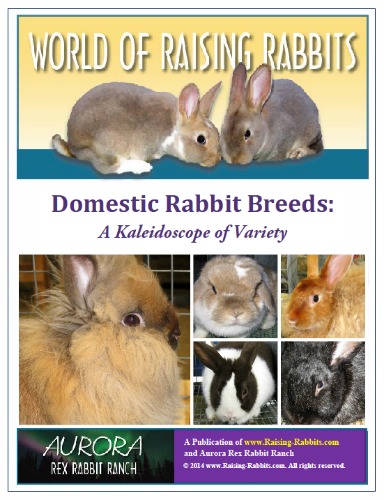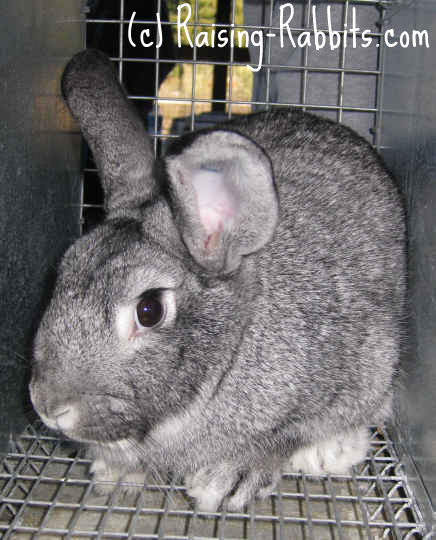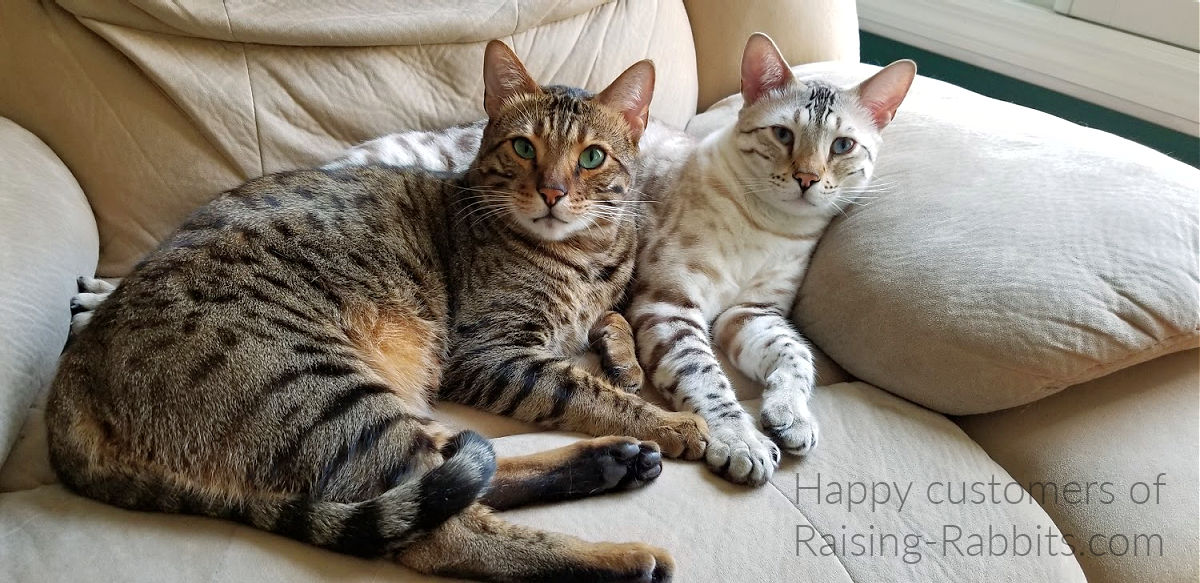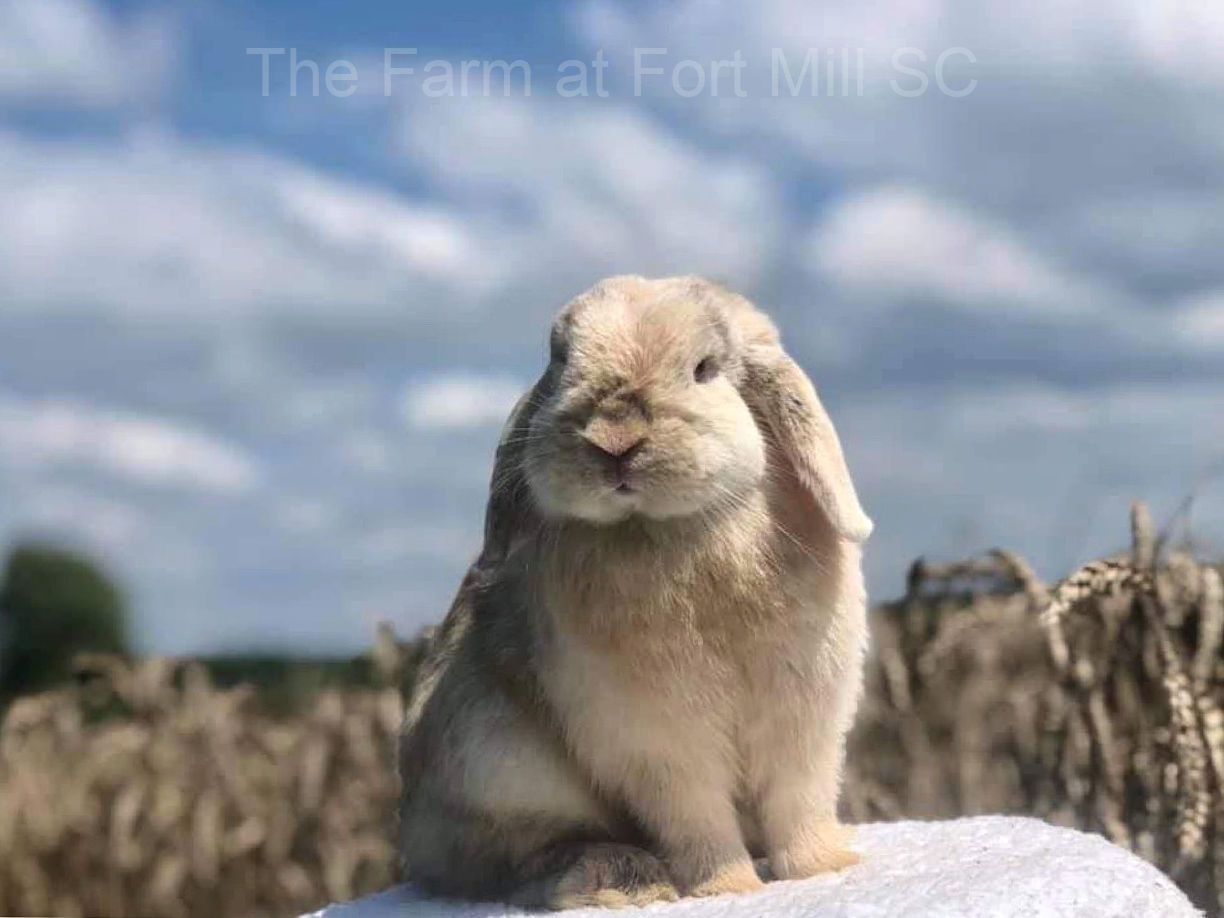Chinchilla Rabbits
Chinchilla Rabbits - Learn about the history and
description of Standard, American, Gigantas and Giant Chinchillas, all
of which have many uses.
Somewhere in the fog-shrouded past of French bunny-history a kit was born to wild agouti colored rabbits, but it was missing half its color. In every other way it looked exactly like its littermates - lush, black and white-tipped fur, but instead of the rufus red or tan sheen underneath the dark tipping that gives chestnut agoutis their wild-rabbit coloring, a silvery pearl glint glowed within the fur of this strange but fascinating young rabbit.
And the French farmer in whose hutch this beautiful rabbit was born was suddenly a rich man.
Well, okay, we don’t know his finances for a fact since he lived in the late 1800’s into the early 1900's, but we do know that chinchilla-colored rabbits flew out of the hands of Le Bonhomme Chinchilla, his nickname on the quays of the Marche aux Oiseaux in Paris where he hawked his rabbits. Parisians were enchanted with these exotic rabbits whose coats were very nearly identical to the color of South American chinchillas.
The ‘official’ Chinchilla breed history lists Monsieur Dybowski, a French engineer and rabbit breeder, as the creator of the Chinchilla rabbit. Without a doubt, chinchilla fur color predated Monsieur Dybowski, who apparently was the driving force behind the development of the Chinchilla breed as it is known in France today.
Mr. Dybowski put together a blue Beveren doe with a chestnut
agouti buck - a local French farm rabbit of no particular bloodline - and
voila, he got a chinchilla-colored rabbit. The quality of the fur on these
first chinchillas was poor, so various breeds were introduced to improve the
density and pearl-white ring color under the jet-black tipping.
1913 was when chinchillas were first shown in France, and in 1914, Mr. Dybowski’s chins took top honors at the national show.
Chinchillas were all the rage in Europe. They arrived in the UK in 1917 and in the United States in 1919, creating a new storm of interest just as the Belgian Hare Boom was waning. They were recognized under the name 'Chinchilla Rabbit' in 1924, in the USA, however as larger chinchilla breeds were developed, the Chinchilla became known as the Standard Chinchilla.
Today there are four separate breeds of Chinchilla rabbits, distinguished primarily by size, for they all have the same black tipped fur with the silvery pearl glint.
While we can't be sure about the number of francs in the
pocket of the old Frenchman Le Bonhomme Chinchilla, we do
know that rabbits, including Chinchillas, did enrich at
least one man. The late Mr. Edward H. Stahl has the distinction of making a
million dollars from his rabbits, including Chinchillas and Giant Chinchillas,
which he helped create.
When the fur industry took a hit due to WWII, interest in
chinchillas began to wane. Two of the breeds below, the American Chinchilla and the
Giant Chinchilla, are listed with the American Livestock Breeds Conservancy under 'critically endangered,' and
'watch,' respectively.
Sherwood Forest Feeds: The best there is on the market, currently.
Adult rabbit feeds available in 4.5 lb and 10 lb bags.
Chinchilla Rabbit Breeds
Standard Chinchilla
Standard Chinchillas weigh up to 7 ½ pounds in the USA. Maximum adult weight in the UK is 6.73 lb (3.060 kg). They are a medium-small breed.
The chinchilla hair shaft is an agouti one, having several rings:
- The base of the hair shaft next to the skin is slate blue
- The intermediate band is a light pearly gray/white, as light as possible
- Next is a band of black
- The very tips of the hair shafts are white, however some of the guard hairs throughout the pelt are entirely jet black
The chinchilla color lightens a bit as it drops down toward the belly, and the belly itself is white, with either white or blue next to the belly skin.
Visit the American Standard Chinchilla national club (USA)
American Chinchilla
Leave it to Americans to not be satisfied with the smallish size of the standard chinchilla. They bred selectively for larger size and finer meat.
In 1924, the American Chinchilla was initially recognized under the name, American Heavyweight Chinchilla, and later shortened to American Chinchilla. American Chinchilla rabbits weigh between 9-12 pounds and carry a commercial body type and typical chinchilla color.
Visit the American Chinchilla national club (USA)
The American Chinchilla was recently removed from the critically endangered list of the American Livestock Breeds Conservancy (ALBC), but it is still on the "watch" list.
Chinchilla Giganta
Development of the Chinchilla Giganta began in 1917 in
England, and refinement continued in Germany and Europe. Chinchilla Rabbits
were interbred with Flemish Giants and other European giant breeds. They were
recognized as a breed in France by 1948. We suspect Chinchilla Gigantas are
significantly larger than the Giant Chinchillas of the USA but identical in every other way.
Giant Chinchilla
Standard Chins had no sooner arrived in America, than folks began working to create a giant version. Mr. Ed Stahl was instrumental in this effort. The Standard Chinchilla was crossed mainly with White Flemish Giants and American Blues, with a touch of New Zealand Whites and Champagne d’Argents.
Giant Chinchillas were recognized by the ARBA in 1928. Today the Giant Chinchilla is heavy boned and long bodied, with commercial value being a prime consideration. Their maximum weight is listed as 16 pounds (does).
Visit the Giant Chinchilla national club (USA)
Giant Chinchillas are included on the "Watch" list of the ALBC, as their numbers have been dwindling.
Are you interested in other breeds of rabbits? Click on the link, or purchase the full-information e-book describing all domestic breeds of rabbits.

Are you trying to decide which breed is best for you?
Do you see a bunny available, but haven't heard of that kind before?
Are you curious about the different types of rabbits?
Check out our ebook, Domestic Rabbit Breeds. We also have lots of other great books with everything you need to know about rabbits, from housing to healthcare. Check out our BOOKSTORE.
As the leaves fall, so do our prices! All of our ebooks are ON SALE, 30% off!
BUY NOW for $12.99 $8.99!
Double-Value Guarantee
Our policy is to always OVER-deliver
on value,
which is why your purchase is fully covered by our
Double-Value
Guarantee.
Go ahead - take any of our e-books for a test drive. Peruse our detailed informational and educational e-books. Examine our plans for building rabbit cages, runs, or metal or PVC hutch frames. Check out the Rabbit Husbandry info e-books.
If you aren't completely satisfied that your e-book purchase is worth at least double, triple or even quadruple the price you paid, just drop us a note within 45 days, and we'll refund you the entire cost. That's our Double-Value Guarantee.
Note: When you purchase your
e-books, they will be in PDF format, so you can download them to any device that
supports PDF format. We advise making a back-up copy to a drive or cloud
account. If the books are lost, you can also purchase another copy from Raising-Rabbits.
Double-Value Guarantee
Our policy is to always OVER-deliver
on value,
which is why your purchase is fully covered by our
Double-Value
Guarantee.
Go ahead - take any of our e-books for a test drive. Peruse our detailed informational and educational e-books. Examine our plans for building rabbit cages, runs, or metal or PVC hutch frames. Check out the Rabbit Husbandry info e-books.
If you aren't completely satisfied that your e-book purchase is worth at least double, triple or even quadruple the price you paid, just drop us a note within 45 days, and we'll refund you the entire cost. That's our Double-Value Guarantee.
Note: When you purchase your
e-books, they will be in PDF format, so you can download them to any device that
supports PDF format. We advise making a back-up copy to a drive or cloud
account. If the books are lost, you can also purchase another copy from Raising-Rabbits.










New! Comments
Have your say about what you just read! Leave me a comment in the box below.